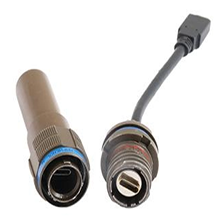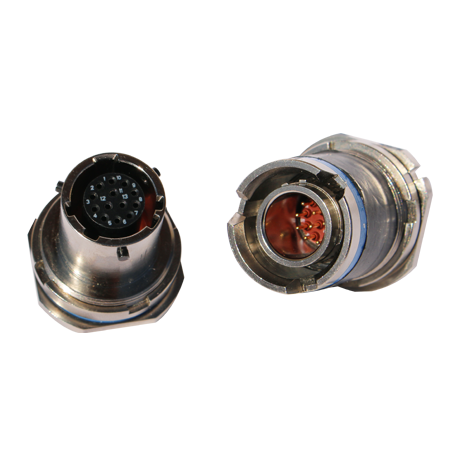In modern military environments, information security is no longer just about digital data. Uncontrolled electromagnetic emissions can also be used to intercept sensitive information. This is the challenge addressed by the Tempest standard, which provides a framework for protecting electronic equipment against such leaks.
While processors, screens, and communication systems are closely monitored, connectivity is sometimes underestimated. However, it plays a key role in meeting Tempest requirements and preserving the integrity of communications.
In this context, cybersecurity is an additional challenge. Hybrid threats combining digital attacks and physical interception via signals or interfaces are on the rise. Connectors are therefore becoming an essential link in the chain, both to limit emissions and to prevent physical and logical intrusions into military systems.
What is Tempest compliance?
The term Tempest refers to a set of standards (including NATO SDIP-27 and SDIP-28) aimed at preventing the emission and exploitation of sensitive information via electromagnetic or acoustic signals emitted unintentionally by electronic equipment.
Certified systems must be designed to minimize these emissions and avoid physical vulnerabilities. Connectors, which link equipment while limiting parasitic radiation, play a strategic role in this regard.
Connectors and cybersecurity: an essential combination
Beyond Tempest requirements, physical interfaces and connectors are potential entry points for cyber-physical attacks:
- Data capture via physical interception of transmission lines (even shielded ones)
- Injection of signals or malware via connected devices (USB, Ethernet, serial)
- Unauthorized access by exploiting physical weaknesses or locking defects
Connectors must therefore not only meet EMC and Tempest requirements, but also incorporate devices designed to strengthen the physical cybersecurity of systems:
- Secure, lockable connectors or plugs to prevent unauthorized connection
- Physical access control systems for ports
- Interface monitoring and detection of abnormal activity (particularly on tactical Ethernet networks)
- Segmented network architecture design to limit propagation in the event of an intrusion
Why is connectivity crucial ?
Connectors and cables are potential vectors for electromagnetic leaks and physical vulnerabilities. Poorly adapted connectors can :
- Act as antennas and amplify interference signals
- Create ground loops that are conducive to radiation
- Allow unsecured physical access to transmitted signals or network interfaces
Conversely, compliant and well-integrated connectors help to :
- Limit spurious emissions via optimized shielding systems
- Maintain electromagnetic shielding continuity throughout the system
- Ensure electromagnetic compatibility (EMC) and compliance with Tempest standards
- Strengthen the physical and logical cybersecurity of connected architectures
Solutions offered by Amphenol Socapex
As a specialist in connectors for harsh environments and military applications, Amphenol Socapex offers a range of connectors and accessories specifically designed for integration into Tempest and secure systems:
- Military Ethernet connectors compliant with EMC requirements
- The µcom 10Gb+ miniature connector
- The µcom 10 Gb+ TV connector
- Locking accessories to ensure optimal protection against unauthorized connections
- CapLock & PlugLock locking rings for 38999, RJFTV, and USBFTV connectors and protective caps
- Shielded circular connectors with guaranteed shield continuity
- The 38999 connector with integrated F472 fitting, protecting against both electromagnetic emissions and physical intrusion
- Fiber optic connectors offer a crucial advantage for both Tempest compliance and military cybersecurity. Unlike traditional copper cabling, fiber optic cables do not radiate electromagnetic signals, effectively eliminating the risk of unintentional emissions that can be intercepted by adversaries. This makes fiber optics a preferred choice for secure communications in defense systems, directly addressing one of Tempest’s primary concerns: the mitigation of signal leakage. In addition to superior electromagnetic isolation, fiber links are physically difficult to tap without detection, providing robust protection against eavesdropping and line interceptio
Our products are already integrated into critical military applications : secure communication systems, command shelters, tactical data centers, and ruggedized networks, where Tempest and physical cybersecurity are inseparable.
Conclusion
Tempest compliance is a strategic issue for the security of armed forces and government institutions. Connectors play an often underestimated but essential role in this.
Faced with the rise of hybrid threats, it is becoming essential to integrate physical and logical cybersecurity measures right from the design stage of architectures. Connectors and interfaces are becoming key control points for preventing unauthorized access and information interception.
By choosing solutions that limit emissions, secure access, and guarantee system integrity, integrators can effectively strengthen the protection of defense equipment and infrastructure.
👉 Contact our experts to discover our connectivity solutions tailored to Tempest and cybersecurity architectures.

Our related article
Related articles






